A hundred years after Fabla salvaje: the fantastic, mirrors and fear
A hundred years after Fabla salvaje: the fantastic, mirrors and fear Cent ans après Fabla salvaje: le fantastique, les miroirs et la peur
Article Sidebar
Main Article Content
Abstract
The year 2023 is ecumenical because it is the hundredth anniversary of the publication of Escalas and Fabla salvaje. In this second novel, Vallejo uses the fantastic, mirrors and fear to materialise the concerns and obsessions of the male subjects, causing chaos in their lives. In contrast, the role of the woman in this work is relevant because she opens the portal to the unknown and is the instrument for the unacceptable to occur. In this short novel, the author of Trilce uses the fantastic to highlight the moral values of Andean women. The irruption of the unbelievable not only causes horror and disquiet in the receiver and the characters, but also destroys the male who questions the honour of the peasant woman. For the purposes of this analysis, we will use some critical studies by Todorov, David Roas, Pampa Arán, among others, as they are relevant to this research.
Article level metrics
Downloads
Metrics
Article Details

This work is licensed under a Creative Commons Attribution 4.0 International License.
La revista utiliza una licencia Creative Commons para mostrar a los lectores y a los usuarios cómo se pueden utilizar los contenidos publicados.
Los contenidos publicados en la revista están bajo una licencia CC-BY 4.0, la cual permite:
- Compartir, copiar y redistribuir el material en cualquier medio o formato.
- Adaptar, remezclar, transformar y construir a partir del material para cualquier propósito, incluso comercialmente.
Bajo los siguientes términos:
- Atribución. Usted debe dar crédito de manera adecuada, brindar un enlace a la licencia, e indicar si se han realizado cambios. Puede hacerlo en cualquier forma razonable, pero no de forma tal que sugiera que usted o su uso tienen el apoyo de la licenciante.
La información de licencia se muestra e incrusta en las páginas de artículos y en ficheros de texto completo como sigue:
«Este obra está bajo una licencia de Creative Commons Reconocimiento 4.0 Internacional».
Arán, P. O. (1999). El fantástico literario: aportes teóricos. Narvaja Editor.
Botton, F. (1983). Los juegos fantásticos. Estudio de los elementos fantásticos en cuentos de tres narradores hispanoamericanos. Universidad Nacional Autónoma de México.
García, M. L. (2017). El amor filial y el miedo en «Más allá de la vida y la muerte» de César Vallejo. Espergesia, 4(3), 15-22. https://doi.org/10.18050/rev.espergesia.v4i3.1375
González Montes, A. (2014). Vallejo, la prosa del universo. Axiara Ediciones; Academia Norteamericana de la Lengua Española.
González Vigil, R. (2012). Prólogo. En C. Vallejo, César Vallejo, narrativa completa (pp. 7-52). Ediciones Copé.
Gutiérrez, M. (1986). Vallejo, narrador. Fondo Editorial del Pedagógico San Marcos.
Jackson, R. (1986). Fantasy: literatura y subversión. Catálogos Editora.
Lovecraft, H. P. (s. f.). El horror sobrenatural en la literatura [Archivo PDF]. Libros Tauro. https://web.seducoahuila.gob.mx/biblioweb/upload/Lovecraft,%20H.P.%20-%20El%20horror%20sobrenatural%20en.pdf
Minc, R. S. (1977). Lo fantástico y lo real en la narrativa de Juan Rulfo y Guadalupe Dueñas. Senda Nueva de Ediciones.
Morales, A. M. (2000). Las fronteras de lo fantástico. Signos, 2(2), 47-61.
Roas, D. (2002). El género fantástico y el miedo. Quimera, (218-219), 41-45.
Roas, D. (2011). Tras los límites de lo real: una definición de lo fantástico. Páginas de Espuma.
Roas, D. y Casas, A. (2016). Voces de lo fantástico en la narrativa española contemporánea. EDA Libros.
Román, M. (1995). El cuento fantástico en Puerto Rico y Cuba: estudio teórico y su aplicación a varios cuentos contemporáneos. Clark Atlanta University.
Samaniego, A. (1954). César Vallejo, su poesía. Juan Mejía Baca & P. L. Villanueva, Editores.
Sardiñas, J. M. (2007). El pensamiento teórico hispanoamericano sobre literatura fantástica: un recuento (1940-2005). En J. M. Sardiñas (ed.), Teorías hispanoamericanas de la literatura fantástica (pp. 7-33). Fondo Editorial Casa de las Américas.
Todorov, T. (1981). Introducción a la literatura fantástica. Premia Editora.
Vallejo, C. (2012). Fabla salvaje. En César Vallejo, narrativa completa (pp. 133-167). Introducción, edición y notas de Ricardo González Vigil. Ediciones Copé.
Vivanco, L. de (2009). El saber de los fantasmas: imaginarios y ficción. Alpha, (29), 217-232. https://www.scielo.cl/pdf/alpha/n29/art15.pdf
Most read articles by the same author(s)
- Mara L. García, «Palmas y guitarra»: physical and spiritual fusion of Vallejo and Georgette , Archivo Vallejo: Vol. 6 No. 11 (2023): January - June
- Mara L. García, Vallejo: Cultura Infantil, part of the Andean archive rescued in Trujillo , Archivo Vallejo: Vol. 4 No. 8 (2021): July - December
Similar Articles
- Antonio Mejía Farje, The short story «Cera» by César Vallejo and the brief narrative by Edgar Allan Poe , Archivo Vallejo: Vol. 6 No. 12 (2023): July - December
You may also start an advanced similarity search for this article.










